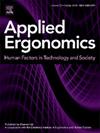Are directional or non-directional hazard warnings more helpful for drivers with homonymous visual field loss?
IF 3.4
2区 工程技术
Q2 ENGINEERING, INDUSTRIAL
引用次数: 0
Abstract
People with homonymous visual field loss (HVFL), the loss of vision in the same half of the visual field in both eyes, are permitted to drive in some jurisdictions. However, the HVFL may cause delayed responses to hazards from the side of their vision loss (blind side). Warnings that indicate hazard direction may be beneficial. This study compared the effects of directional and nondirectional vibrotactile warnings on gaze behaviors and driving responses to pedestrian hazards in a driving simulator. Directional warnings consisted of vibrations on either the left or right side of the seat cushion to indicate the direction of an approaching hazard, while nondirectional warnings provided vibrations on both sides. Warnings were triggered at a 3-s time-to-collision, allowing HVFL drivers time to react. Both warning types were equally efficacious in reducing blind side collisions, with no difference in hazard brake response times. However, differences in gaze fixation behaviors suggest that participants with HVFL used the directional information, as they self-reported, to guide their gaze toward hazards on the blind side. Directional warnings were strongly preferred and resulted in quicker fixations on hazards.
方向性或非方向性危险警告对同向视野丧失的驾驶员更有帮助吗?
在一些司法管辖区,患有同侧视野丧失(HVFL)的人,即双眼同一部分视野丧失的人,是允许开车的。然而,HVFL可能导致对其视力丧失(盲侧)的危害反应延迟。指示危险方向的警告可能是有益的。本研究在驾驶模拟器中比较了定向和非定向振动触觉警告对注视行为和驾驶对行人危险反应的影响。方向性警告包括在坐垫的左侧或右侧振动,以指示接近危险的方向,而非方向性警告则在两侧提供振动。警告会在碰撞前3秒触发,让HVFL驾驶员有时间做出反应。两种警告类型在减少盲区碰撞方面同样有效,危险制动响应时间没有差异。然而,注视注视行为的差异表明,HVFL的参与者使用方向信息,正如他们自己报告的那样,引导他们的目光转向盲区的危险。定向警告是最受欢迎的,可以更快地确定危险。
本文章由计算机程序翻译,如有差异,请以英文原文为准。
求助全文
约1分钟内获得全文
求助全文
来源期刊

Applied Ergonomics
工程技术-工程:工业
CiteScore
7.50
自引率
9.40%
发文量
248
审稿时长
53 days
期刊介绍:
Applied Ergonomics is aimed at ergonomists and all those interested in applying ergonomics/human factors in the design, planning and management of technical and social systems at work or leisure. Readership is truly international with subscribers in over 50 countries. Professionals for whom Applied Ergonomics is of interest include: ergonomists, designers, industrial engineers, health and safety specialists, systems engineers, design engineers, organizational psychologists, occupational health specialists and human-computer interaction specialists.
 求助内容:
求助内容: 应助结果提醒方式:
应助结果提醒方式:


